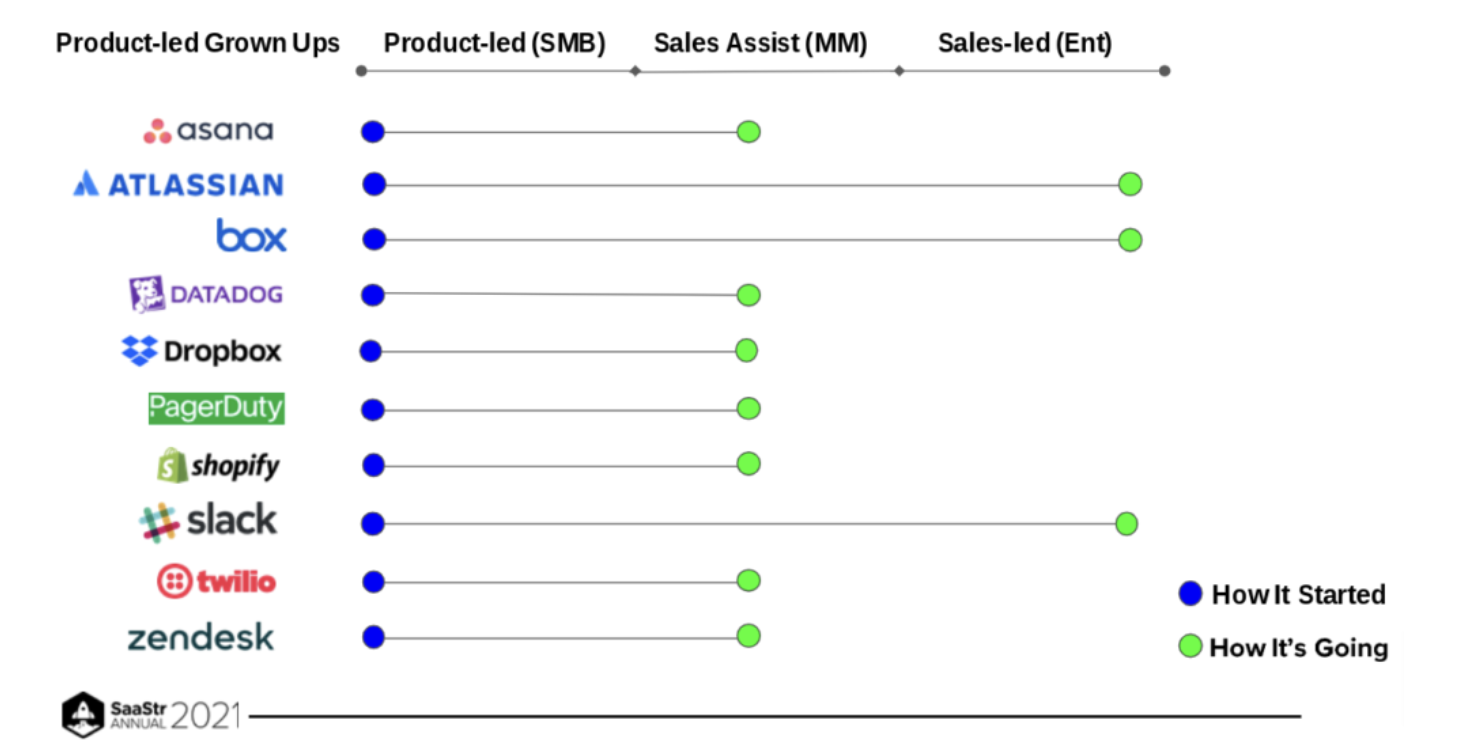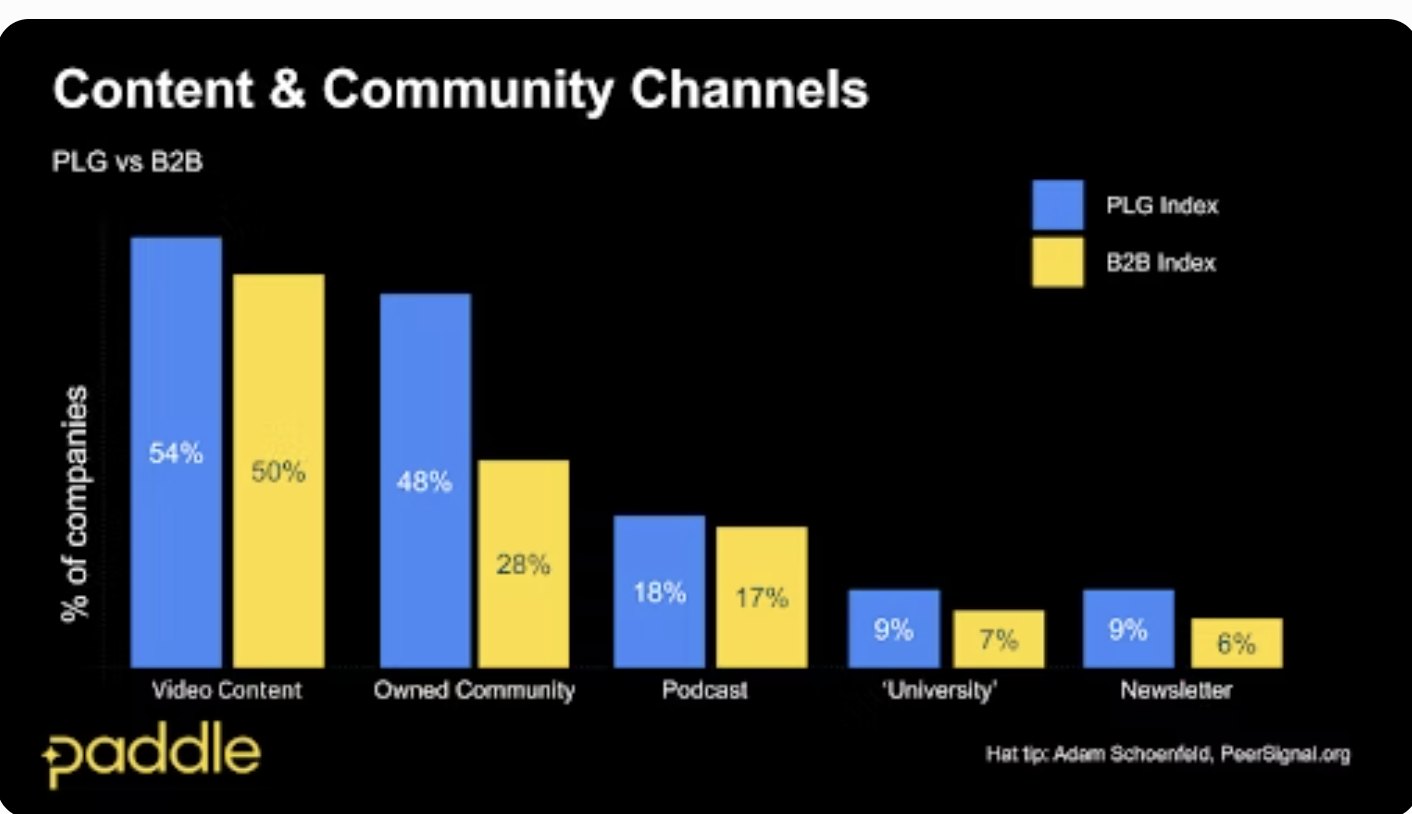Christian Owens
More posts from Christian Owens
Following the valuation collapse of the last 12 months, the phrase “efficient growth” is reverberating around SaaS boardrooms worldwide. Every software leader is seeking to boost revenues, cut costs, and demonstrate a clear path to profitability.
Sitting at the heart of this conversation is product-led growth (PLG), a strategy that sees acquisition, monetization and retention of customers through a product lens, rather than through the hiring of expensive marketing, sales and success organizations.
With standout examples like Figma’s $28B acquisition by Adobe, ChatGPT’s two-month race to 100 million users, and Hubspot’s pivot to PLG that has helped drive almost $2B in revenue, most SaaS boards are seeking to understand how they can benefit from this proven sales motion. PLG is fast becoming a necessity, not a choice.
To find out what makes a fine-tuned and well-oiled PLG strategy, we analyzed data from more than 30,000 SaaS companies that generated more than $28B ARR collectively through the Paddle and ProfitWell platforms. Based on this data, I believe there are five key ways that software companies big and small can level up their product-led, efficient growth.
1. Fix the leaks in your funnel
With your product handling much of your customer acquisition and retention in a PLG setup, you’ll likely experience what is known as ‘delinquent’ churn – customers leaving your service involuntarily due to leaks in your funnel.
This can account for 20-40% of your overall churn rate and is usually to do with failed payments, meaning that leveling up your billing processes should be a top priority. Common ‘leaks’ in the funnel you should be keeping an eye on include:
- Insufficient customer funds, which is particularly common for payments made by credit cards with limits. To fix this, try retrying the payments – using smart technology to do so at a time when it’s more likely to be successful – or offer payment methods that can access multiple sources of funds like PayPal.
- Cross-border transaction failures, which sometimes happens due to different standards between banks. A strong solution is to bank locally where your customers are based, or to use a payment provider which already has local banking relationships.
- Currency conversations, which can often create fraud triggers. Selling to customers in their local currency is essential to prevent this: our data shows that doing so can increase payment acceptance rates by 1 to 11%.
2. Go hybrid or go home
Unsurprisingly, product-led growth motions let the product take center stage, with acquisition, conversion, retention, and expansion all being driven by the product itself. Instead of booking a demo with a sales team, customers are usually offered trials, freemium models and other self-serve calls to action, streamlining the acquisition process.
But that doesn’t mean sales isn’t important, especially as your company scales up. The industry is full of success stories in which small SaaS companies graduate from an exclusively product-led growth strategy to a sales-assisted, or sales-led growth motion (SLG). When they do this, their customer base shifts from individual users and small teams to larger businesses. Just look at the trajectory of some of cloud’s most successful names:

This means that, however you start, you’re going to need those product-led and sales-led motions to work alongside each other at some point if you want to diversify your customer base and grow sustainably. Think PLG in the short-term, hybrid in the long.
3. It pays to pay(ment)
At its core, product-led growth is all about a product selling itself, which usually means starting at a low price point. So to make money, your business needs to sell lots of copies, which means going global and selling in as many markets as possible. In sum, PLG and internationalization must go hand in hand.
This is where payments come in. Payments play a crucial role in the acquisition journey and need dedicated resources to make them friction-free, especially when expanding overseas.
Let’s take free trials (a core staple of PLG) for example. If you offer a free trial and ask for credit card details to access that trial, you’re pushing people through the buyer journey. But if you don’t optimize that workflow for global payment methods — which vary from market to market — you can expect a 15% drop-off on conversions.
Therefore, think of payments as an essential part of your product experience and PLG motion, and assign a product team to work on optimizing it. In addition, investing in a good payments infrastructure provider will help streamline this process too, as they handle everything from subscriptions to tax and compliance as well as creating a friction-free payment experience for customers.
4. Community is key
A solid product-led growth motion should also be married with an engaging community content offering. After all, if PLG is all about the customer buying, then the onus is on your startup to provide something up front to help prospects understand what value you offer before they sign-up, and without speaking to your team. Content is one way to do this.
Data we pulled with PeerSignal below shows just how many PLG software sellers are using content and media to build up brand awareness and showcase their value:

We launched our own content hub to deliver all of our podcasts, web series and documentaries in one space. In an economic climate where many businesses are looking for helpful content, offering help now will help you convert more customers in the short-term and ensure you’re top of mind later for those who aren’t yet ready to buy.
5. The price is right
SaaS businesses generally aren’t good at updating their pricing regularly – despite the fact that research shows that those who do grow more quickly and have a higher average revenue per user (ARPU).
Optimizing your product pricing – which in a PLG motion again means thinking internationally – is therefore another great way to maximize conversations. Consider these two strategies:
- Cosmetic localization: Ensuring that prices display in local currencies automatically within your product – making the buying process smoother for the customer.
- True localization: Changing your pricing based on customers’ willingness to pay (WTP) in different markets. Do your research on the buying conventions and competitive landscape in the markets you sell — or want to sell — into, to determine how best to price your products in each region.
Our research found that software companies that offer two different currencies grow 12.7% faster – and those that offer over 25 currencies grow 25% faster.
Let the product lead the way, the right way
Adopting a PLG strategy is crucial for SaaS companies to boost revenue, remain competitive and achieve sustainable growth in today’s challenging market. Don’t have one? You risk being disrupted by the next competitor that does.
Yet to truly bring out the best of PLG for selling SaaS, you’re going to have to do a bit more than just slapping a free version of your product on your website. Any company looking to level up its PLG motion must adopt a global mindset, thinking how they can tweak prices for different geographies to boost sales and revenue. A payments-first mentality and moving towards a hybrid model can also prove essential for long-term success.
Put the above tips into practice, and you will level up your product-led growth strategy and boost the growth and profitability of your SaaS company for years to come.
The data in this article is based on an analysis of over 30,000 subscription and software-as-a-service (SaaS) companies on the Paddle and ProfitWell platforms.































Comment